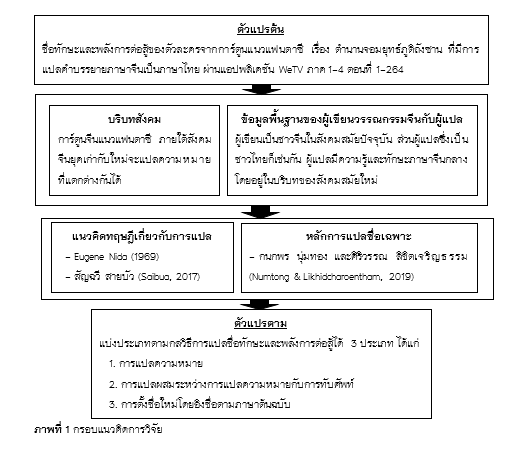A Study of Strategies Used in Translating the Names of Skills and Battle Powers from Chinese to Thai in the Chinese Fantasy Anime Entitled ‘Soul Land’ (斗罗大陆)
Main Article Content
Abstract
This article aimed to study strategies for translating the names of skills and battle powers in the fantasy anime entitled ‘Soul Land’ from Chinese to Thai. The names of skills and battle powers were collected from the subtitles translated from Chinese into Thai in the Soul Land anime’s seasons 1-4, episodes 1-264 broadcasted via the WeTV application. A name list form was adopted as a tool to collect data and classify translation strategies. The data was described by descriptive analytics. The findings showed that there were totally 509 skill and battle power names which were translated from Chinese into Thai. There were 3 translation strategies employed: 1) meaning translation (420 names or 82.51%), 2) combination of meaning translation and transcription or transliteration (26 names or 5.10%); and 3) generating new names based on the original (63 names or 12.37%). The most commonly used strategy among the translators was found to be the meaning translation in order to be convey the meanings which were easy for audiences to understand and the translators avoided the unnecessary transcription or transliteration because of three factors: 1) the past influence of Chinese martial arts-based movies over the present, 2) the association between use of translation strategies and generation of skill and battle power names, and 3) the tendency to use Mandarin for transcription or transliteration of proper names. Three types of translation errors were found: 1) incorrect translation of meanings, 2) selection of translated words with a unity lack, and 3) word misspelling caused by incorrect use of tone marks due to 2 factors: 1) translations in each episode carried out by different translators without discussion and agreement on using identical words in the entire series, and 2) lack of checking translated subtitles for accuracy.
Downloads
Article Details

This work is licensed under a Creative Commons Attribution-NonCommercial-NoDerivatives 4.0 International License.
The articles published are copyrighted by the Graduate School, Chiang Mai Rajabhat University.
The opinions expressed in each article of this academic journal are solely those of the individual authors and do not reflect the views of Chiang Mai Rajabhat University or its faculty members. The responsibility for the content of each article rests entirely with the respective authors. In the event of any errors, the authors alone are responsible for their own articles.
References
Duangmala, V. & Numtong, K. (2022). A study of translation strategies and errors in translating cultural words and phrases from Thai to Chinese in “Rang Zong” movie subtitles. Chinese Studies Journal. Kasetsart University, 15(2), 251-291. [In Thai]
Gong, S. F. (2019). Research on translation of the culture – loaded word in Chinese cartoons ——Take “Uproar in heaven” and “Nezha conquers the dragon king” as examples. Journal of Xinzhou Teacher University. Xinzhou Teacher University, 35(3), 83-87. [In Chinese]
Jantapan, K. & Chawla, C. (2022). An analysis of strategies used in translating Chinese period drama (古装) titles into Thai. Chinese Studies Journal. Kasetsart University, 15(1), 33-71. [In Thai]
Kittopakarnkit, K. (2020). Translating Thai horror film titles into Chinese: Strategies and analysis. Life Sciences and Environment Journal. Pibulsongkram Rajabhat University, 21(2), 354–373. [In Thai]
Nida, E. A. & Taber, C. R. (1969). The theory and practice of translation, with special reference to bible translating. Leiden: E.J Brill.
Numtong, K. (2009). A study of the translation of Chinese literature on Sai Han during the reign of King Rama I. Journal of Studies in the Field of Humanities. Kasetsart University, 16(2), 86-98. [In Thai]
Numtong, K. & Likhidcharoentham, S. (2019). Principles and precautions in translating Chinese-Thai language and Thai-Chinese language. Chinese Studies Journal. Kasetsart University, 12(2), 105-151. [In Thai]
Numtong, K. (2022). The translation techniques for Chinese fictional prose into Thai: From past to present. Sinsat: Liberal Arts Thesis for the 60th Anniversary of the Faculty of Liberal Arts Thammasat University (pp. 525-565). Nonthauri: Read Journal. [In Thai]
Pinpongsub, J. (2018). The method of translating the title of Thai movies to Chinese. Veridian E Journal: Humanities, Social Sciences and Arts. Silpakorn University, 11(3), 1471-1491. [In Thai]
Pongprasit, T. & Petcharathip, K. (2021). A study of characteristics and strategies for translating prohibited words in the Chinese to Thai subtitles of the Chinese Boys’ love series: A case study of the boys love series “Addicted”. Chinese Studies Journal. Kasetsart University, 14(2), 265-306. [In Thai]
Saengjantanu, E. (2020). Translating Thai drama titles and Thai TV series titles into Chinese: Strategies and analysis. Journal of Humanities. Chiang Mai University, 21(1), 116-136. [In Thai]
Saibua, S. (2017). Principles of translation. (9th ed.). Bangkok: Thammasat University Press. [In Thai]
Srivichien, Y. & Netsombutphol, J. (2021). Translation strategies of Chinese series titles in WeTV application to Thai languange. Journal of Humanities and Social Sciences. Suratthani Rajabhat University, 13(2), 155-175. [In Thai]
Tosanguan, K. (2022). A study of Thai translation name patterns of Chinese horror films titles from 1980 to 2013. HUSO Journal of Humanities and Social Sciences. Phranakhon Rajabhat University, 6(2), 52-67. [In Thai]
Woralaknakul, M. (2017). An analytical study of the methods used in translating the martial arts novel, Lian Cheng Jue (A Deadly Secret). Journal of Humanities and Social Sciences Prince of Songkla University, 13(2), 79-103. [In Thai]
Wen, R. M. (2022). Subtitle Translation of Chinese Animated Film from the Perspective of Adaptation Theory: Nezha, I Am the Destiny as an Example. Open Access Library Journal, 9, 1-9.
Zhang, W. (2020). Soul land (斗罗大陆). Retrieved from https://shorturl.asia/iB1qI [In Thai]


